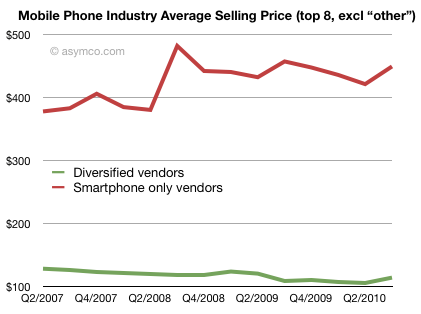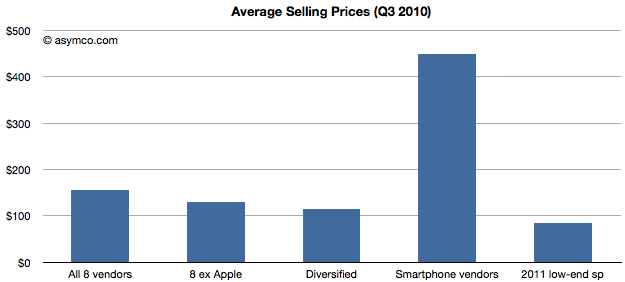In a recent article I made the claim:
My bet is that by the end of 2012, it will be hard to find any branded phones which won’t run a smartphone
I also showed how pricing has evolved over the last three years.
Two days later an article in Fortune’s Google24/7 blog highlighted the possible price points of low-end smartphones:
I had a chance to speak with Jim Tran, VP/GM – Handset Line of Business for Broadcom, who was able to elaborate on the details of the new processor and what it meant for the industry. Here are some of Broadcom’s bullet points:
- The BCM2157 baseband, since it combines many functions on one chip, is able to run more efficiently, meaning less battery power will be needed than on current basic handsets
- Low-cost, low-power, 65 nm digital CMOS process means the silicon will be cheap
- The dual-core processors will run at 500-800mhz.
- Supports portable Wifi hotspot and Android 2.2 and up
But the kicker is the price. Tran says that phones made from the BCM2157 chipset will retail for under $100 and may dip as low as $75. Those devices should debut in just 3-6 months (and we might hear about them next month at CES)….
To be clear, That sub $100 price is not the cost of materials, it is the suggested retail price after the manufacturers (and carriers) have taken their profits.
via 2011 will be the year Android explodes – Google 24/7 – Fortune Tech.
My own data shows that the average selling price for the top eight phone vendors for Q3 of 2010 was $156. Smartphone-only vendors were charging $450 on average and diversified vendors selling both smart and non-smart phones were charging $144 on average.
Nokia’s ASP for its entire line-up was $88 (spread over about 84 million non-smart and 26.5 million smartphones).
What strikes me about the claim from Broadcom is that a $100 retail price for a smartphone implies an ASP of about $85 or so (assuming $15 or a very modest 18% channel mark-up).
That means that a smartphone could be built using this chip which would have nearly half the average price of all branded phones sold last quarter.
It would also be priced cheaper than the average price Nokia charged for all its phones (75% of which were non-smart phones.)
And this type of phone could be available not in three years in three months.
The chart above shows how prices could collapse.
Of course, low price is not the only condition for the widespread substitution of smart devices in vendor portfolios. But it does take away a significant objection. It no longer seems far-fetched to say that in another two years the price points for smartphones will be low enough to make them marketable in all markets. This may in fact be true next year.
I suspect that non-branded vendors will lead the way and make these devices widely available in emerging markets. The question will then be entirely up to the branded vendors whether they will follow or will they try to market dumb phones vs. smart phones at similar price points. Will buyers opt for a branded device with no ecosystem or unbranded device with the Android ecosystem?
It becomes harder to envision any reason why non-smart devices will earn positions in portfolios two years from now.
Note that I’m not suggesting that the market for high-end smartphones is threatened yet–there is still a lot of innovation that still needs to happen to shape that market into one of mobile computing (vs. mobile phoning).
Instead, what I am suggesting is that the bottom of the phone market is very vulnerable to becoming smart. This may sound like an odd sort of disruption, but it’s a very sinister threat to companies who are in the business of selling brands and not platforms.
Discover more from Asymco
Subscribe to get the latest posts sent to your email.


